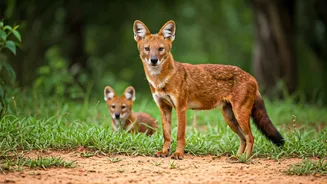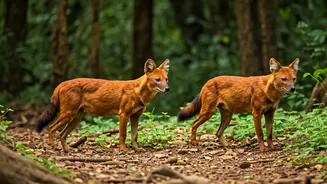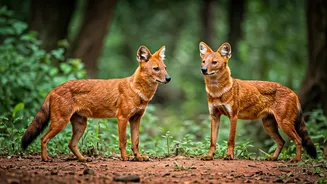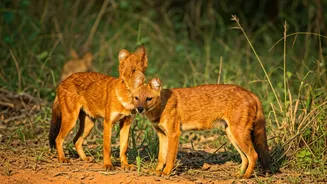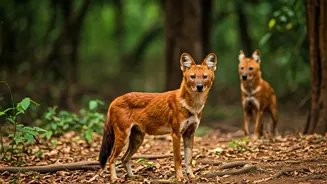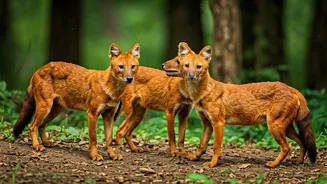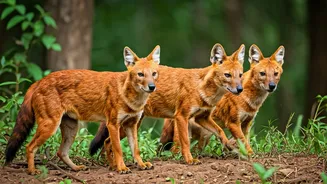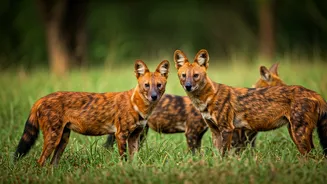Introduction to Dholes
The wild dog, scientifically known as Cuon alpinus, and more commonly referred to as the dhole, is a fascinating canid that faces the constant threat of
extinction. These social animals live in packs, often exhibiting cooperative hunting strategies to take down prey much larger than themselves. Their survival is threatened by habitat loss, prey depletion, and conflicts with humans. Conservation efforts are crucial to ensure the dhole's survival. These include habitat preservation, anti-poaching measures, and community engagement to mitigate human-wildlife conflicts. Protecting these animals is not only important for the health of the species but also vital for maintaining the balance of their ecosystems. The dhole plays a pivotal role in regulating prey populations and contributing to the overall biodiversity of the habitats they occupy. Various conservation programs are underway, but continued support and awareness are essential to protect the dhole and its future.
Kanha National Park
Kanha National Park, located in Madhya Pradesh, is a prime location to spot dholes due to its extensive grassland and dense forest habitats. It boasts a thriving ecosystem that allows for successful dhole packs. The park's diverse terrain provides a perfect environment for the canids, facilitating both hunting and protection. The management of Kanha has been instrumental in the conservation of several endangered species. This includes active measures against poaching and habitat destruction. Visitors have a high chance of encountering dholes while exploring the park through safari. Guides and trackers contribute greatly to wildlife monitoring and conservation efforts. Their expertise helps in identifying dhole activity, tracking their movements, and minimizing disturbances within the park. Kanha is considered a significant conservation success story, displaying how meticulous habitat management and anti-poaching tactics can greatly contribute to wildlife recovery.
Tadoba-Andhari Tiger Reserve
Tadoba-Andhari Tiger Reserve in Maharashtra presents another excellent opportunity to sight dholes. The combination of dense deciduous forests and water bodies creates ideal conditions for dholes to thrive. The reserve is well-known for its high density of tigers, coexisting with the dholes, which highlights the area's rich biodiversity. The Tadoba authorities actively promote conservation through anti-poaching patrols and community outreach programs, vital to the welfare of dholes. Sightings of dholes in Tadoba are relatively frequent, providing visitors with amazing wildlife viewing. The management of the reserve places a strong emphasis on maintaining the integrity of the ecosystem. This involves carefully controlling tourist activities to minimize disturbance to the natural habitats. Tadoba's commitment to protecting its ecosystem ensures it remains a stronghold for the endangered dholes.
Bandhavgarh National Park
Bandhavgarh National Park, also located in Madhya Pradesh, is celebrated for its dense tiger population, but it is also a potential habitat for dholes. The diverse terrain, featuring undulating hills and lush valleys, creates ample opportunities for dholes. The park's ecosystem supports various wildlife, including herbivores such as deer and wild pigs, which are prey for the dholes. Bandhavgarh's conservation efforts are focused on the protection of both the dholes and their prey. This integrated approach helps in maintaining a balanced ecosystem that allows these predators to thrive. Regular monitoring and patrolling are carried out to mitigate illegal activities. These activities are critical for maintaining the dhole populations. By supporting ecosystem balance and promoting wildlife management, Bandhavgarh ensures the wellbeing of the dholes and other animals.
Periyar National Park
Periyar National Park in Kerala, with its scenic beauty and tropical climate, is also home to dholes. The reserve's lush evergreen forests and open grasslands offer suitable environments for dholes to flourish. The park has a rich ecosystem, comprising diverse flora and fauna, that supports the dhole population. Conservation strategies in Periyar include habitat preservation and tackling poaching, which are very essential for protecting the species. The park authorities closely work with local communities to promote wildlife conservation through various educational initiatives and eco-tourism programs. Periyar National Park's active conservation efforts and commitment to environmental protection make it a haven for the dholes and a valuable example of biodiversity conservation in India. This blend of natural beauty and effective conservation strategies makes Periyar a must-visit destination for those interested in seeing these wild dogs.
